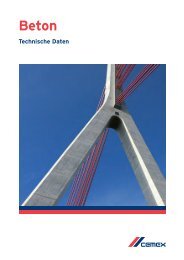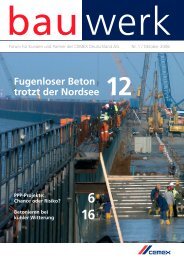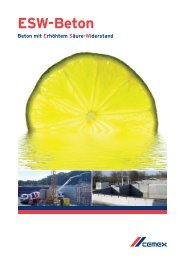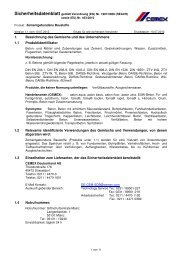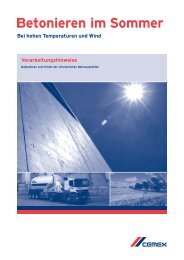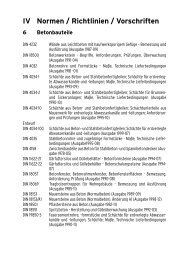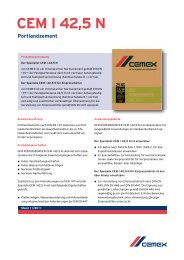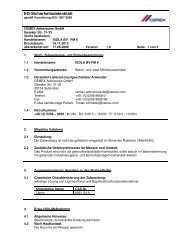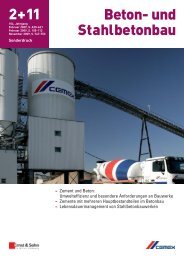building a better future - Cemex
building a better future - Cemex
building a better future - Cemex
Create successful ePaper yourself
Turn your PDF publications into a flip-book with our unique Google optimized e-Paper software.
During 2011 we carried out a detailed revision of the<br />
methodology applied in all CEMEX production sites in our<br />
three main businesses (cement, ready mix, and aggregates)<br />
to measure waste disposal. In this review we developed a<br />
standard way of calculating the figures and we have identified<br />
CEMEX operations that were using different criteria or<br />
methods. As a result of this review we are restating our figures<br />
for both hazardous and non-hazardous waste disposal<br />
corresponding to the years 2009 and 2010, so that they can<br />
be comparable to those obtained for 2011. The changes we<br />
made are not material and they allow us to <strong>better</strong> reflect the<br />
reality in our operations.<br />
We have reduced our hazardous waste disposal from 50,868<br />
to 39,904 tons during 2011. By business, hazardous waste<br />
disposal increased in cement from 14,164 to 15,492 tons,<br />
it also increased in ready mix from 1,272 to 1,784 tons and<br />
it was reduced in aggregates from 35,433 to 22,628 tons.<br />
Furthermore, we have increased our non-hazardous waste<br />
disposal from 385,977 to 414,600 tons. By business, nonhazardous<br />
waste disposal in cement significantly increased<br />
from 66,139 to 96,372 tons, we had a slight increase in ready<br />
mix from 313,515 to 315,476 tons and and it was significantly<br />
reduced in aggregates from 6,322 to 2,752.<br />
The volume of returned concrete material as a percentage<br />
of the total volume we delivered was 0.76% in 2011, a slight<br />
increase over the 0.73% shown in 2010. Secondary and<br />
recycled aggregate used as a direct replacement of primary<br />
aggregates (as a percentage of the total volume sold) was<br />
0.27% in 2011, a slight increase over the 0.25% we showed<br />
for 2010.<br />
10,964<br />
tons of hazardous<br />
waste disposal reduction<br />
during 2011<br />
deepening our commitment to<br />
biodiversity management<br />
In 2010, CEMEX completed a biodiversity scoping study in<br />
collaboration with BirdLife International, determining that<br />
131 of its operations are situated in proximity to areas<br />
of high biodiversity value. These areas include wildlifeprotection<br />
zones, important bird habitats, and other areas of<br />
national, regional, and international biodiversity significance.<br />
While some facilities operating in these areas have already<br />
launched voluntary conservation projects and other activities<br />
to address biodiversity issues, CEMEX has committed to<br />
establishing comprehensive Biodiversity Action Plans (BAPs)<br />
at 100 percent of its active sites adjacent to high biodiversity<br />
value areas by 2015 1 .<br />
During 2011, CEMEX and BirdLife International worked to<br />
meet this goal by creating a standard for the development<br />
of BAPs. The standard ensures that individual operations are<br />
able to produce, quickly and systematically, their own BAPs<br />
tailored to the particular biodiversity values they possess<br />
and challenges they face. The CEMEX BAP Standard includes<br />
methodologies for the following:<br />
• Assessing biodiversity value<br />
• Setting appropriate targets for biodiversity management<br />
• Developing effective action plans to reach performance<br />
goals<br />
• Engaging external stakeholders and partners around biodiversity<br />
issues<br />
1 As the number of active CEMEX operations can change<br />
year to year, there are currently 103 active sites that meet<br />
our criteria for BAP implementation.<br />
update on El Carmen<br />
Through our signature conservation initiative, El Carmen, we continue<br />
working to protect a variety of plant and animal species in one of the<br />
world’s most biologically diverse regions. With approximately 200,000<br />
hectares of land under management, El Carmen is home to a variety of<br />
ecosystems, including riparian areas along the Rio Grande River, Chihuahuan<br />
desert lowlands, grasslands, pine-oak woodlands, and high-elevation<br />
pine-fir forest.<br />
During 2011, the region has experienced a severe drought condition (the<br />
worst in the last 70 years for this region), requiring supplemental wildlife<br />
feeding and oversight efforts. Fortunately, animal population surveys show<br />
stable numbers for the mammals that have been reintroduced to El Carmen,<br />
with desert bighorn sheep maintaining a population of 200, mule deer<br />
900, and pronghorns 95.<br />
One of the main objectives of El Carmen is to educate, share knowledge<br />
and cooperate with our neighbors. El Carmen staff members offer workshops<br />
to local communities and landowners on avoiding conflicts with<br />
black bears, and in 2011, provided support to the Mexican government in<br />
efforts to control a wildfire and rescue wildlife in areas near El Carmen.<br />
Each year, an average of two research projects are conducted at the reserve.<br />
In 2011, El Carmen supported the completion of two Master of Science<br />
research projects, the results of which will be used to inform <strong>future</strong> wildlife<br />
conservation activities.<br />
To learn about El Carmen, visit<br />
http://www.cemex.com/elcarmen/default.asp<br />
< previous 28 next>



